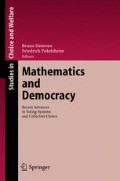Abstract
This paper characterizes divisor methods for vector and matrix apportion problems with very simple properties. For the vector problem—a vector gives the votes of parties or the populations of states, a single number the size of the house—they are shown to be the only methods that are coherent with the definition of the corresponding divisor method when applied to only two states or parties. For the matrix problem—rows correspond to districts, columns to parties, entries to votes for party-lists, and the number of seats due to each row (or district) and each column (or party) is known—one extra property is necessary. The method must be proportional: it must give identical answers to a problem obtained by re-scaling any rows and/or any columns of the matrix of votes.
Access this chapter
Tax calculation will be finalised at checkout
Purchases are for personal use only
Preview
Unable to display preview. Download preview PDF.
References
M. Balinski (2004), Le suffrage universel inachevé, Éditions Belin, Paris.
M. Balinski (2002), “Une ‘dose’ de proportionnelle: le système électorale mexicain,” Pour la science, 58–59.
M. Balinski (2005), What is just? American Mathematical Monthly, 112, 502–511.
M. Balinski and G. Demange (1989a), An axiomatic approach to proportionality between matrices, Mathematics of Operations Research 14, 700–719.
M. Balinski and G. Demange (1989b), Algorithms for proportional matrices in reals and integers, Mathematical Programming 45, 193–210.
M. Balinski and S. Rachev (1997), Rounding proportions: methods of rounding, The Mathematical Scientist 22, 1–26.
M. Balinski and V. Ramírez (1997), Mexican electoral law: 1996 version, Electoral Studies 16, 329–340.
M. Balinski and V. Ramírez (1999a), Mexico’s 1997 apportionment defies its electoral law, Electoral Studies 18, 117–124.
M. Balinski and V. Ramírez (1999b), Parametric methods of apportionment, rounding and production, Mathematical Social Sciences 37, 107–122.
M.L. Balinski and H.P. Young (1982), Fair Representation: Meeting the Ideal of One Man, One Vote, Yale University Press, New Haven; 2nd ed., Brookings Institution Press, Washington, D.C., 2001.
F. Pukelsheim and C. Schuhmacher (2004), Das neue Zürcher Zuteilungsverfahren für Parlamentswahlen, Aktuelle Juristichische Praxis 5, 505–522.
P. Zachariassen and Martin Zachariassen (2005), A comparison of electoral formulae for the Faroese Palriament (The Løgting), Technical report, NáttúruvÍsindadeildin, Føroya, 1 August 2005.
Author information
Authors and Affiliations
Editor information
Editors and Affiliations
Rights and permissions
Copyright information
© 2006 Springer Berlin · Heidelberg
About this paper
Cite this paper
Balinski, M. (2006). Apportionment: Uni- and Bi-Dimensional. In: Simeone, B., Pukelsheim, F. (eds) Mathematics and Democracy. Studies in Choice and Welfare. Springer, Berlin, Heidelberg. https://doi.org/10.1007/3-540-35605-3_3
Download citation
DOI: https://doi.org/10.1007/3-540-35605-3_3
Publisher Name: Springer, Berlin, Heidelberg
Print ISBN: 978-3-540-35603-5
Online ISBN: 978-3-540-35605-9
eBook Packages: Business and EconomicsEconomics and Finance (R0)

